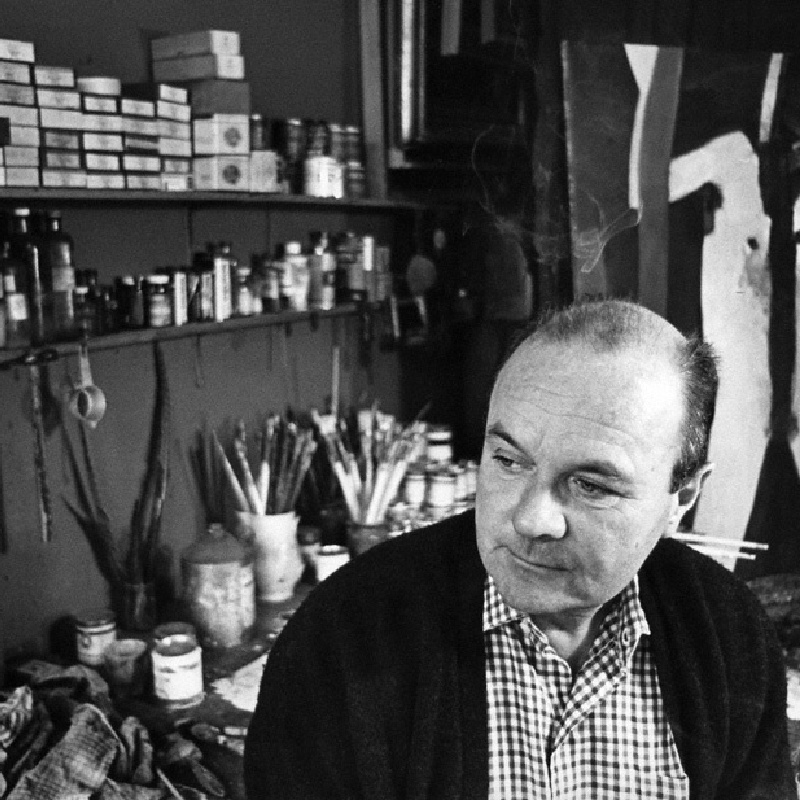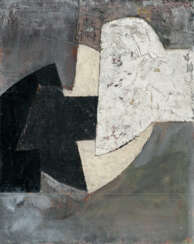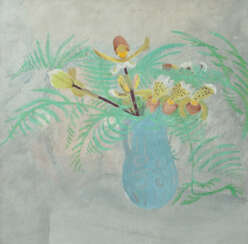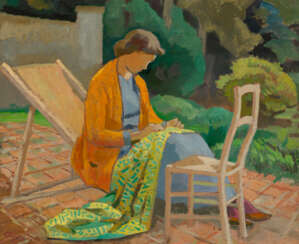
Paintings — Modern British and Irish Art Day Sale

Ithell Colquhoun is a British surrealist painter, writer, poet, and playwright who hails from India. She has been called "the mother of British surrealism. Influenced by Salvador Dali, she depicted plants and the world around her in what she herself called "magical realism.

George Peter Lanyon was a British painter of landscapes leaning heavily towards abstraction. Lanyon was one of the most important artists to emerge in post-war Britain. Despite his early death at the age of forty-six he achieved a body of work that is amongst the most original and important reappraisals of modernism in painting to be found anywhere. Combining abstract values with radical ideas about landscape and the figure, Lanyon navigated a course from Constructivism through Abstract Expressionism to a style close to Pop. He also made constructions, pottery and collage.

Ben Nicholson, an English artist, is celebrated for his significant contributions to abstract art. Born into an artistic family, Nicholson's work evolved from figurative art to embrace and lead in the development of abstract art in Britain. His early career was marked by experimentation with Cubism and interaction with influential artists like Barbara Hepworth, Henry Moore, Piet Mondrian, and Pablo Picasso, which profoundly shaped his artistic direction.
Nicholson's art is notable for its sensitive balance of tone and texture, employing dynamic and rhythmic lines that abstractly reference architectural forms and societal structures. His technique involved meticulous carving, painting, and the innovative use of color, especially in his later works where he explored the interplay of light and form to create poetic, abstract landscapes. His contributions were not just confined to his own practice; through collaborative projects and influential writings, he played a pivotal role in the discourse of modernist art, advocating for abstract art's broader appreciation.
Noteworthy pieces of Nicholson's work, including "March 1963 (Archimedes)" and "June 1961 (green goblet and blue square)," among others, are housed in prestigious collections like the Tate Gallery, Tate St Ives, Kettle's Yard Art Gallery in Cambridge, The Hepworth Wakefield, Pallant House Gallery in Chichester, and the Pier Arts Centre in Stromness, Orkney.
Nicholson's legacy as a pioneer of abstract art in the UK is secured through his innovative approaches and influential partnerships, which have left an indelible mark on the landscape of 20th-century art. His work continues to inspire and resonate, reflecting a deep understanding of the abstract's power to express the complexities of human experience and the natural world.
For collectors and experts in art and antiques interested in the pivotal movements of 20th-century art, Ben Nicholson's oeuvre offers a rich field of study and appreciation. To stay updated on new product sales and auction events related to Ben Nicholson's work, signing up for updates is a step towards deepening your understanding and appreciation of this key figure in modernist art.

Ben Nicholson, an English artist, is celebrated for his significant contributions to abstract art. Born into an artistic family, Nicholson's work evolved from figurative art to embrace and lead in the development of abstract art in Britain. His early career was marked by experimentation with Cubism and interaction with influential artists like Barbara Hepworth, Henry Moore, Piet Mondrian, and Pablo Picasso, which profoundly shaped his artistic direction.
Nicholson's art is notable for its sensitive balance of tone and texture, employing dynamic and rhythmic lines that abstractly reference architectural forms and societal structures. His technique involved meticulous carving, painting, and the innovative use of color, especially in his later works where he explored the interplay of light and form to create poetic, abstract landscapes. His contributions were not just confined to his own practice; through collaborative projects and influential writings, he played a pivotal role in the discourse of modernist art, advocating for abstract art's broader appreciation.
Noteworthy pieces of Nicholson's work, including "March 1963 (Archimedes)" and "June 1961 (green goblet and blue square)," among others, are housed in prestigious collections like the Tate Gallery, Tate St Ives, Kettle's Yard Art Gallery in Cambridge, The Hepworth Wakefield, Pallant House Gallery in Chichester, and the Pier Arts Centre in Stromness, Orkney.
Nicholson's legacy as a pioneer of abstract art in the UK is secured through his innovative approaches and influential partnerships, which have left an indelible mark on the landscape of 20th-century art. His work continues to inspire and resonate, reflecting a deep understanding of the abstract's power to express the complexities of human experience and the natural world.
For collectors and experts in art and antiques interested in the pivotal movements of 20th-century art, Ben Nicholson's oeuvre offers a rich field of study and appreciation. To stay updated on new product sales and auction events related to Ben Nicholson's work, signing up for updates is a step towards deepening your understanding and appreciation of this key figure in modernist art.

Rosa Winifred Nicholson was a British painter. Winifred Nicholson was a colourist who developed a personal impressionistic style, concentrating on domestic still life objects and landscapes. She often combined the two subjects as seen in her painting From Bedroom Window, Bankshead showing a landscape viewed through a window, with flowers in a vase in the foreground.

Ivon Hitchens was an English painter who started exhibiting during the 1920s. He became part of the 'London Group' of artists and exhibited with them during the 1930s. His house was bombed in 1940 during World War II. Hitchens and his family abandoned London for the Sussex countryside, where he acquired a small area of woodland on Lavington Common (near Petworth), and lived there in a caravan, which he gradually augmented with a series of buildings. It was here that the artist further developed his fascination with the woodland subject matter, and this pre-occupation continued until the artist’s death in 1979.

Roger Eliot Fry was an English painter and critic, and a member of the Bloomsbury Group. Establishing his reputation as a scholar of the Old Masters, he became an advocate of more recent developments in French painting, to which he gave the name Post-Impressionism.

Roger Eliot Fry was an English painter and critic, and a member of the Bloomsbury Group. Establishing his reputation as a scholar of the Old Masters, he became an advocate of more recent developments in French painting, to which he gave the name Post-Impressionism.

Ivon Hitchens was an English painter who started exhibiting during the 1920s. He became part of the 'London Group' of artists and exhibited with them during the 1930s. His house was bombed in 1940 during World War II. Hitchens and his family abandoned London for the Sussex countryside, where he acquired a small area of woodland on Lavington Common (near Petworth), and lived there in a caravan, which he gradually augmented with a series of buildings. It was here that the artist further developed his fascination with the woodland subject matter, and this pre-occupation continued until the artist’s death in 1979.

Euan Ernest Richard Uglow was a British painter best known for his paintings of nudes and still lifes. Uglow was a meticulous perfectionist. He painted at great length, constantly measuring the model's proportions and correcting them, making his work almost look like sculpture. The artist's carefully structured nudes and still lifes have a cold aesthetic.

John Ronald Craigie Aitchison was a Scottish painter. He was best known for his many paintings of the Crucifixion, one of which hangs behind the altar in the chapter house of Liverpool Cathedral, Italian landscapes, and portraits (mainly of black men, or of dogs). His simple style with bright, childlike colours defied description, and was compared to the Scottish Colourists, primitivists or naive artists, although Brian Sewell dismissed him as "a painter of too considered trifles".
His career-long fascination with the crucifixion was triggered by a visit to see Salvador Dalí's Christ of St John of the Cross in 1951 after it was acquired by the Kelvingrove Gallery.

Sidney Nolan was an influential Australian artist known for his diverse body of work and pioneering contributions to modern art. His most famous work centers on the Ned Kelly series, which depicts the life of the legendary Australian bushranger and outlaw. This series became iconic for its unique depiction of Kelly's armor and for symbolizing Australian history and identity.
Sidney Nolan was deeply interested in Australian history and mythology, often exploring themes of bush life and historical figures such as the Kelly Gang, shipwreck victim Eliza Fraser, and the explorers Burke and Wills. He was inspired by various modernist artists, such as Paul Cézanne, Pablo Picasso, and Henri Matisse, and his work often incorporated bold colors and simplified forms.
Despite lacking extensive formal art training, Sidney Nolan's approach to art was innovative and experimental. His techniques drew from diverse influences, including children's art and modernist styles, while his use of color and texture gave his work a striking visual impact. This diversity in approach led him to explore various media, ensuring his body of work remained varied and vibrant.
Sidney Nolan's legacy lives on through his paintings, which can be found in museums and galleries worldwide. He painted in series, creating visual poems with a significant emotional punch. His work's emotional expression and ability to engage the viewer on an emotional level are part of what makes his art so compelling and enduring.
To stay updated on new product sales and auction events related to Sidney Nolan, consider signing up for newsletters or updates from relevant art and auction houses. These updates can provide insights into new exhibitions, available artworks, and other events related to Nolan's work.

Sidney Nolan was an influential Australian artist known for his diverse body of work and pioneering contributions to modern art. His most famous work centers on the Ned Kelly series, which depicts the life of the legendary Australian bushranger and outlaw. This series became iconic for its unique depiction of Kelly's armor and for symbolizing Australian history and identity.
Sidney Nolan was deeply interested in Australian history and mythology, often exploring themes of bush life and historical figures such as the Kelly Gang, shipwreck victim Eliza Fraser, and the explorers Burke and Wills. He was inspired by various modernist artists, such as Paul Cézanne, Pablo Picasso, and Henri Matisse, and his work often incorporated bold colors and simplified forms.
Despite lacking extensive formal art training, Sidney Nolan's approach to art was innovative and experimental. His techniques drew from diverse influences, including children's art and modernist styles, while his use of color and texture gave his work a striking visual impact. This diversity in approach led him to explore various media, ensuring his body of work remained varied and vibrant.
Sidney Nolan's legacy lives on through his paintings, which can be found in museums and galleries worldwide. He painted in series, creating visual poems with a significant emotional punch. His work's emotional expression and ability to engage the viewer on an emotional level are part of what makes his art so compelling and enduring.
To stay updated on new product sales and auction events related to Sidney Nolan, consider signing up for newsletters or updates from relevant art and auction houses. These updates can provide insights into new exhibitions, available artworks, and other events related to Nolan's work.

Sidney Nolan was an influential Australian artist known for his diverse body of work and pioneering contributions to modern art. His most famous work centers on the Ned Kelly series, which depicts the life of the legendary Australian bushranger and outlaw. This series became iconic for its unique depiction of Kelly's armor and for symbolizing Australian history and identity.
Sidney Nolan was deeply interested in Australian history and mythology, often exploring themes of bush life and historical figures such as the Kelly Gang, shipwreck victim Eliza Fraser, and the explorers Burke and Wills. He was inspired by various modernist artists, such as Paul Cézanne, Pablo Picasso, and Henri Matisse, and his work often incorporated bold colors and simplified forms.
Despite lacking extensive formal art training, Sidney Nolan's approach to art was innovative and experimental. His techniques drew from diverse influences, including children's art and modernist styles, while his use of color and texture gave his work a striking visual impact. This diversity in approach led him to explore various media, ensuring his body of work remained varied and vibrant.
Sidney Nolan's legacy lives on through his paintings, which can be found in museums and galleries worldwide. He painted in series, creating visual poems with a significant emotional punch. His work's emotional expression and ability to engage the viewer on an emotional level are part of what makes his art so compelling and enduring.
To stay updated on new product sales and auction events related to Sidney Nolan, consider signing up for newsletters or updates from relevant art and auction houses. These updates can provide insights into new exhibitions, available artworks, and other events related to Nolan's work.






































































